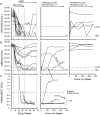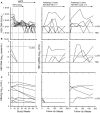Persistent Control of Hepatitis B Virus and Hepatitis Delta Virus Infection Following REP 2139-Ca and Pegylated Interferon Therapy in Chronic Hepatitis B Virus/Hepatitis Delta Virus Coinfection
- PMID: 33553968
- PMCID: PMC7850315
- DOI: 10.1002/hep4.1633
Persistent Control of Hepatitis B Virus and Hepatitis Delta Virus Infection Following REP 2139-Ca and Pegylated Interferon Therapy in Chronic Hepatitis B Virus/Hepatitis Delta Virus Coinfection
Abstract
The nucleic acid polymer REP 2139 inhibits assembly/secretion of hepatitis B virus (HBV) subviral particles. Previously, REP 2139-Ca and pegylated interferon (pegIFN) in HBV/hepatitis delta virus (HDV) coinfection achieved high rates of HDV RNA and hepatitis B surface antigen (HBsAg) loss/seroconversion in the REP 301 study (NCT02233075). The REP 301-LTF study (NCT02876419) examined safety and efficacy during 3.5 years of follow-up. In the current study, participants completing therapy in the REP 301 study were followed for 3.5 years. Primary outcomes were safety and tolerability, and secondary outcomes were HDV functional cure (HDV RNA target not detected [TND], normal alanine aminotransferase [ALT]), HBV virologic control (HBV DNA ≤2,000 IU/mL, normal ALT), HBV functional cure (HBV DNA TND; HBsAg <0.05 IU/mL, normal ALT), and HBsAg seroconversion. Supplemental analysis included high-sensitivity HBsAg (Abbott ARCHITECT HBsAg NEXT), HBV pregenomic RNA (pgRNA), HBsAg/hepatitis B surface antibody (anti-HBs) immune complexes (HBsAg ICs), and hepatitis B core-related antigen (HBcrAg). Asymptomatic grade 1-2 ALT elevations occurred in 2 participants accompanying viral rebound; no other safety or tolerability issues were observed. During therapy and follow-up, HBsAg reductions to <0.05 IU/mL were also <0.005 IU/mL. HBsAg ICs declined in 7 of 11 participants during REP 2139-Ca monotherapy and in 10 of 11 participants during follow-up. HDV functional cure persisted in 7 of 11 participants; HBV virologic control persisted in 3 and functional cure (with HBsAg seroconversion) persisted in 4 of these participants. Functional cure of HBV was accompanied by HBV pgRNA TND and HBcrAg <lower limit of quantitation. Conclusion: REP 2139-Ca + pegIFN is not associated with long-term safety or tolerability issues. The establishment of HDV functional cure and HBV virologic control/functional cure and HBsAg seroconversion are durable over 3.5 years and may reflect removal of integrated HBV DNA from the liver. Further investigation is warranted in larger studies.
© 2020 The Authors. Hepatology Communications published by Wiley Periodicals LLC on behalf of the American Association for the Study of Liver Diseases.
Figures



References
-
- Gish RG, Yi DH, Kane S, Clark M, Mangahas M, Baqai S, et al. Coinfection with hepatitis B and D: epidemiology, prevalence and disease in patients in Northern California. J Gastroenterol Hepatol 2013;28:1521‐1525. - PubMed
-
- Sureau C, Negro F. The hepatitis delta virus: replication and pathogenesis. J Hepatol 2016;64(Suppl.):S102‐S116. - PubMed
-
- Wedemeyer H, Manns MP. Epidemiology, pathogenesis and management of hepatitis D: update and challenges ahead. Nat Rev Gastroenterol Hepatol 2010;7:31‐40. - PubMed
-
- Chen HY, Shen DT, Ji DZ, Han PC, Zhang WM, Ma JF, et al. Prevalence and burden of hepatitis D virus infection in the global population: a systematic review and meta‐analysis. Gut 2019;68:512‐521. - PubMed
Publication types
MeSH terms
Substances
Associated data
LinkOut - more resources
Full Text Sources
Medical
Miscellaneous

